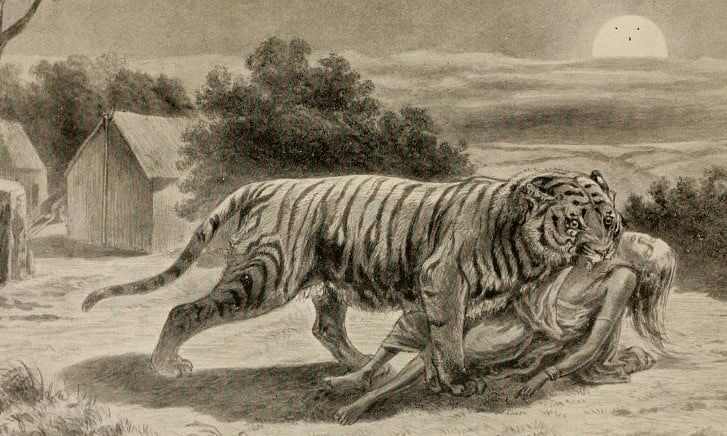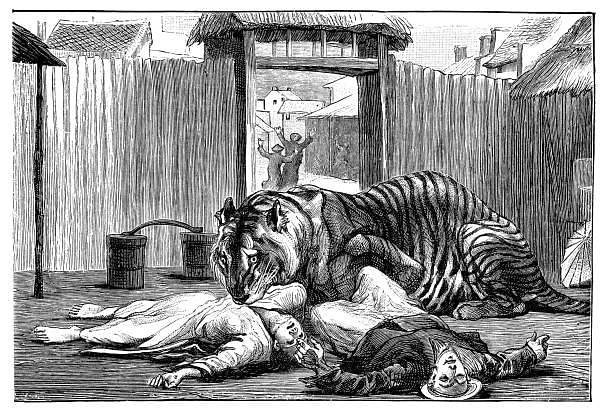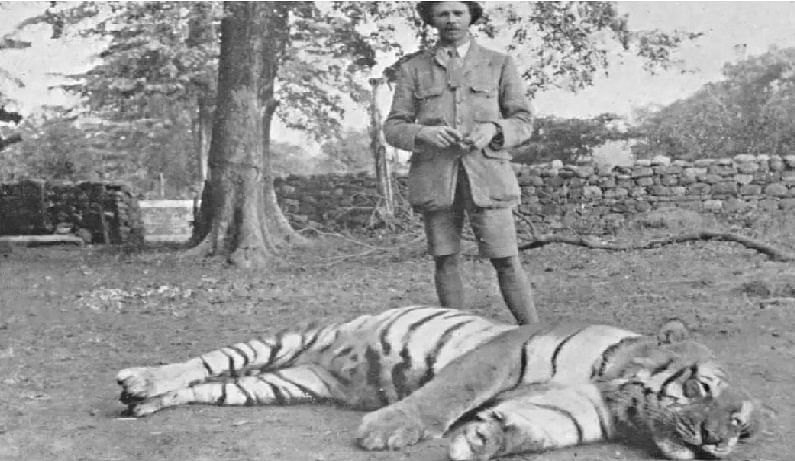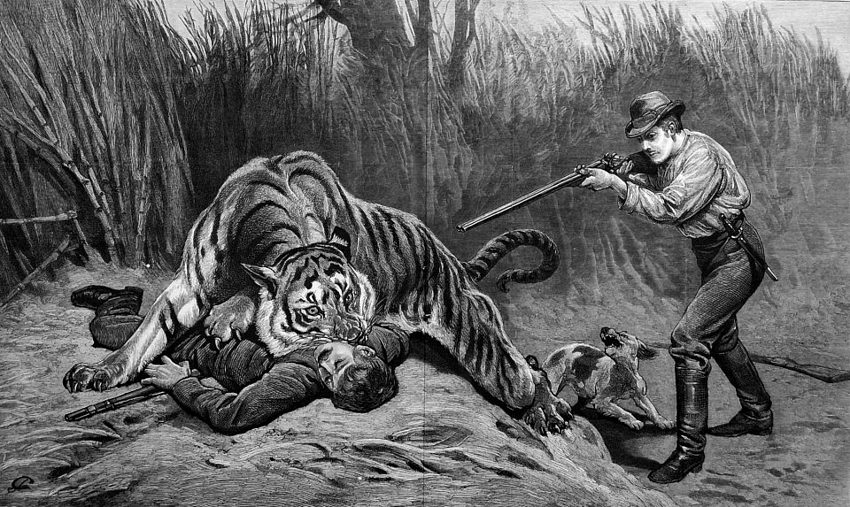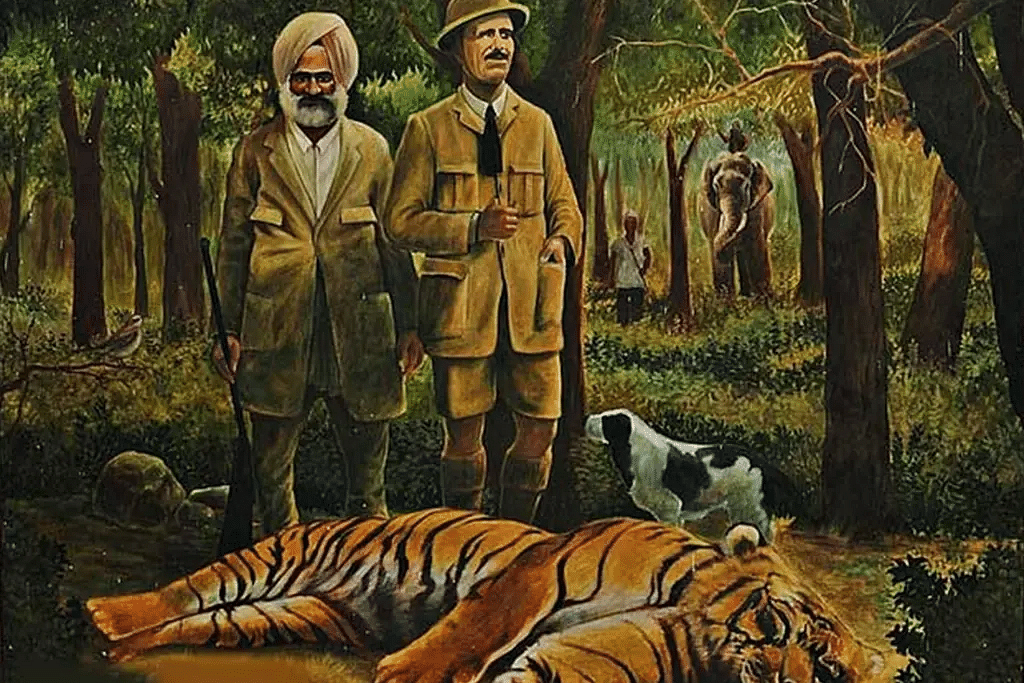In a quiet, sunlit room, Jim Corbett sat alone, lost in thought. He stared at the old maps and photographs on the walls, that reminded him of a dark chapter in his past. He remembered the chilling stories about the “Devil of Champawat,” a name that sent shivers down the spines of the villagers. It was hard to believe that one creature, responsible for over 400 deaths, could teach him such profound lessons, ultimately changing him from a skilled hunter into a passionate conservationist.Who was this terrifying creature? While hunting in Malani, Jim Corbett first heard about a tigress that would become the dreaded Champawat Man-Eater later. Despite many skilled hunters and government rewards, no one had managed to kill it.
When Corbett arrived in Naini Tal, the terror was at its peak. The deputy minister, desperate for help, explained how people had locked themselves inside, too scared to step outside, fearing the next attack. Killing the beast had become a fight for the village’s survival.
Could Corbett stop this deadly predator, or would he become her next victim? What terrible things had she done to make entire villages live in fear? As I wrote this story, even I got goosebumps, hoping such a nightmare never returns.
Come, let’s uncover the terrifying tale of the “Champawat Man-Eater.”
Where the Terror of the Champawat Tiger Began
The Champawat Tiger earned a terrifying spot in the Guinness Book of World Records for causing the most deaths by a single animal. Holding the title of the “deadliest tiger in the world,” the Champawat Tigress hailed from the forests of Nepal. In the late 1890s, she killed over 200 people there. After being driven out of Nepal, this wandering terror crossed the border into India and continued her reign of terror, terrorizing the villages of the Kumaon region. Over the next four years, she added 234 more victims to her already horrifying tally.
Scary, isn’t it? On one side, there’s the Machli Tigress of Ranthambore, famous as the “Most Photographed Tigress in the World” and the “Pride of Ranthambore.” On the other side, there’s this terrifying tigress whose actions struck such deep fear that people felt their hearts in their mouths, creating a wave of horror that shook entire communities.
You might be wondering why no one was able to kill her. Despite the efforts of skilled hunters and huge rewards offered by the government, every attempt failed. Teams of Gurkhas were sent out from Almora, but they too had no luck. The tigress continued to roam freely, and people began to lose hope of ever escaping her terror. But then, who killed the Champawat tiger?
The Tigress’s Final Fatal Attack
One day, a group of about twenty women and girls were out gathering oak leaves for their cattle. The women had left two hours before noon and climbed into trees to collect leaves. Some of them had chosen a tree on the edge of a ravine, which was about four feet deep and ten to twelve feet wide. After gathering leaves, one of the women began climbing down when the tiger, who had approached silently, suddenly stood on its hind legs and grabbed her foot. She lost her grip on the branch and was pulled into the ravine. Once there, the tiger released her foot and caught her by the throat, killing her. It then carried her away into some thick undergrowth.
The attack happened just a few feet away from the other women, who saw the whole thing. Terrified, they ran back to the village. The men, who were just starting their midday meal, quickly armed themselves with drums, metal pots, and anything else that could make noise, and went out to search for the tiger, with the women following behind.
When they reached the ravine, they were debating what to do next when the tiger roared loudly from nearby bushes. Terrified, everyone fled back to the village. Once they caught their breath, they began accusing each other of being the first to run and causing the panic. After all, who knew that surviving a tiger attack also meant surviving the blame game?
The Arrival of a New Hope as Jim Corbett Steps In
As the villagers anxiously feared that they might become the tiger’s next victim, a skilled hunter known for dealing with man-eaters arrived in Naini Tal. Jim Corbett was approached by Berthoud, the Deputy Commissioner of Naini Tal at the time. Berthoud described the growing terror and urged Corbett to help. Corbett agreed to start the hunt for the Champawat tiger as soon as he received news of the next human kill.Just a week later, Berthoud came rushing back, his face pale with panic. He reported the shocking news of a woman being killed by the tiger; the very incident I mentioned above. This horrific event was the catalyst that finally pulled Jim Corbett into the desperate search for the fearsome predator.
When Jim Corbett arrived in the village, the streets were silent, as if no human foot had ever walked on them. The villagers were so terrified of the tiger that they stayed locked inside their homes even though it was still daylight. To get them to come out, Corbett’s men built a fire in the courtyard, which finally encouraged the villagers to slowly emerge.
For five long days, the village had been gripped by fear, with no one daring to step outside their homes. The villagers faced the threat of starvation, their food running out quickly. Meanwhile, villagers informed that the “Shaitan” was still close by, its frightening roars echoing through the night and its shadow seen in the fields just that day. The fear was intense and time was running out for the desperate villagers.
Other Interesting Stories From India: Story of Last Konyak Headhunters of Nagaland: Hunting And Tattoos
The Hunting Strategy of Jim Corbett
Corbett was known for his patience and ability to observe tiger behavior. He would often spend days or even weeks tracking a particular tiger, studying its habits and movements. Despite his reputation as a hunter, Corbett was committed to ethical hunting practices. He believed in only killing tigers that posed a direct threat to human life.One day, a villager rushed to Corbett with news of the tiger’s location. This was exactly what Corbett had been waiting for! He quickly headed into the forest, hoping to end the tiger’s reign of terror. He tracked the tiger through the rugged and rocky terrain. As he moved through the tiger’s territory, he knew that if the tiger decided to pounce, his chances of getting a clear shot were slim.
With the sun setting and darkness approaching, Corbett realized that hunting in the dark wouldn’t work. So, he decided to return to the village and come up with a new plan: lure the tigress out of her territory and trick her into a more manageable location.
The Final Hunt of Champawat Tiger
The final hunt of the Champawat Tigress took place on April 12, 1911. Jim Corbett set up a strategic plan to finally take down the feared Champawat Tigress. He positioned the villagers on a hill, opposite another hill, with a wide ravine in between. His plan was to use the villagers to make as much noise as possible to drive the tigress out of her hiding spot and force her into the open. Once she was in sight, Corbett would take his shot from the neighboring hill.
As the villagers eagerly began making noise from about 150 yards away, Corbett raced across the rough terrain to his spot in the tall grass, praying for a good shot. He hoped he wouldn’t miss his chance. The tigress, though old, still appeared majestic. Corbett fired his first shot, hitting her in the rump. The tigress snarled and ran.
Corbett quickly aimed again but missed as the tigress slipped up a rock. Frustrated, he heard the villagers cheering, thinking the tigress had been killed. But as he searched, he spotted the tigress standing on a rock. She lowered herself and bared her teeth, ready to charge. Corbett took his shot, and this time, the bullet struck its mark. The tigress collapsed and died. The man-eater’s reign of terror had finally come to an end.
Other Interesting Stories From India: Beautiful Yet Tragic – Story Of Nohkalikai Waterfalls Cherrapunji
She Was No Monster: The Real Story
Wondering if I’m inhumane for saying this—that she was not a devil, but just a misunderstood predator? You might be shocked to learn the truth. No doubt she caused immense pain, changing many lives forever. But it was a pain for her too. She didn’t want to prey on humans but had no other choice but to survive.When Jim Corbett went to see her after killing her, he noticed that something was off with the tigress’s mouth, and upon closer examination, he discovered that her upper and lower canine teeth on the right side were broken, the upper one split in half and the lower one shattered down to the bone. His heart broke!
This painful, permanent injury was caused by a gunshot wound, which made it impossible for her to hunt her usual prey. Tigers rely on their powerful jaws and sharp teeth to take down their targets, but with her damaged canines, the tigress was driven to desperation. She resorted to attacking humans, who were easier to catch and kill. This injury is what ultimately forced her to become a man-eater.
The Reign of Terror Finally Ended
The villagers were furious, shouting “Shaitan, Shaitan!” and demanding that the tigress be handed over to them so they could hack her into pieces. Their anger was justified; they had lost so much, and everyone had suffered in some way. However, Corbett couldn’t allow the villagers to desecrate the animal. Gradually, they calmed down.The reign of terror had finally ended. The villagers, though relieved, requested that the tigress not be skinned immediately. They wanted the women and children to witness her death, believing that unless they saw her lifeless form with their own eyes, they would never believe their dreaded enemy was truly gone.
Also Read: 12 Offbeat Best Places to Visit in Uttarakhand During Summers
The Legacy of Jim Corbett
After ending the reign of terror caused by the Champawat Tigress, Jim Corbett’s perspective on wildlife began to shift. He came to understand that these animals, often driven by desperation due to human interference or injury, weren’t evil; they were just trying to survive.This new perspective led him to move from being a hunter of dangerous animals to becoming a devoted conservationist. Corbett spent the later years of his life working to protect India’s wildlife and their natural habitats.
The Jim Corbett Champawat Tiger story is also documented in his book “,” where he recounts his encounters with the deadliest tiger in the world—the Champawat Tigress.
In honor of his dedication, Jim Corbett National Park was established in 1957. This park, located in the foothills of the Himalayas, became a safe haven for tigers and other wildlife. Uttarakhand tour packages often include a visit to this iconic park, offering a chance to experience its natural beauty and rich wildlife. It stands today as one of the most renowned tiger reserves in the world, symbolizing the balance between human needs and nature preservation.
Had there been such conservation efforts during the time of the Champawat Tigress, her story might have been different. With a sanctuary like Jim Corbett National Park in place, protecting tigers and their habitats, the Champawat Tigress might never have been driven to become a maneater of Kumaon.




